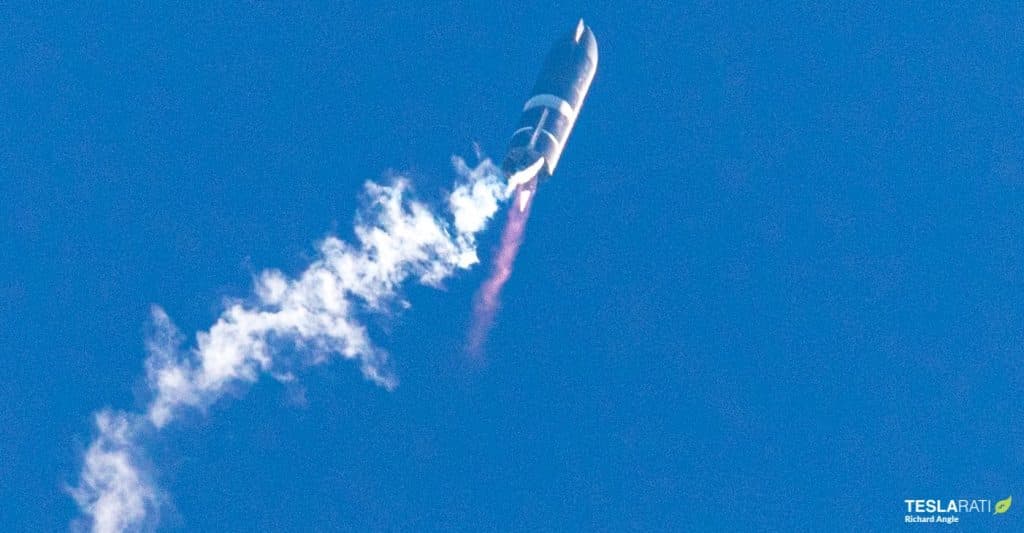Update: SpaceX has published a video taken near the launch pad of Starship nailing an exotic ‘flip’ maneuver shortly before a hard landing destroyed the rocket.
Both the company, test directors, and CEO Elon Musk have all made it abundantly clear that despite the explosive end, Starship SN8’s maiden flight was a spectacular success, proving that the rocket is capable of performing several previously-unproven maneuvers and surviving the associated stresses. Notably, according to tweets posted by Musk not long after, Starship SN8 performed almost perfectly, failing a soft landing (already proven by SN5 and SN6) solely because of low pressure in the rocket’s secondary ‘header’ fuel tank.

For unknown reasons, that tank or its associated plumbing were unable to maintain the pressure needed to feed Raptor with enough propellant, resulting in fuel starvation mid-burn. A lack of fuel and surplus of oxygen effectively turned the landing engine into a giant oxygen torch, melting the copper walls of its combustion chamber (hence the green plume). Had the header tank maintained the correct pressure, SN8 would have very likely landed intact (or at least had a much softer landing).
In simpler terms, it seems that Raptor isn’t to blame for Starship SN8’s failed landing and fixing a pressurization problem will be dramatically faster and easier than rectifying a rocket engine design flaw.

In perhaps the most spectacular aerospace demonstration since Falcon Heavy’s 2018 debut, SpaceX’s first full-size Starship prototype came within a hair’s breadth of sticking the landing after an otherwise successful ~12.5 km (7.8 mi) launch debut.
To quote SpaceX’s test director, heard live on the company’s official webcast moments after Starship serial number 8 (SN8) exploded on impact, “Incredible work, team!” For most, praise shortly after a rocket explosion could easily feel nonsensical, but in the context of SpaceX’s iterative approach to development, a Starship prototype failing just moments before the end of a multi-minute test can be considered a spectacular success.
Chock full of surprises, Starship SN8 ignited its three Raptor engines for the third time and lifted off at 4:45 pm CST (UTC-6) on the program’s high-altitude launch debut.

About 100 seconds after liftoff, already representing the longest-known ignition of one – let alone three – Raptor engines, one of those three engines appeared to shut down, causing the two remaining engines to gimbal wildly in an effort to retain control. Another two minutes after that, one of those Raptors also shut down, leaving one engine active. That one engine continued to burn for another minute and a half, producing just enough thrust to more or less maintain Starship SN8’s altitude at apogee while performing a bizarre horizontal slide maneuver.



Finally, at a bit less than five minutes after liftoff, Starship cut off all Raptor engines and began falling back to earth. Looking spectacularly similar to fan-made renders and CGI videos of the highly-anticipated ‘skydiver’ or ‘belly-flop’ maneuver, Starship – belly down – spent around two minutes in a rock-solid freefall, using four large flaps to maintain stability.



Around 4:52 pm, Starship SN8 performed exactly as expected, igniting one – and then two – Raptor engines while fully parallel to the ground to complete an aggressive 90-degree flip, transitioning into vertical flight for an attempted landing. Unfortunately, although it’s difficult to judge what was intentional and what was not, things began to go wrong after that point -visible in the form of one of the two reignited Raptors flashing green before shutting down.
At the same time, the plume of the lone remaining engine flashed an electric green, quite literally consuming its copper-rich internals in an unsuccessful attempt to slow Starship down. According to SpaceX CEO Elon Musk, Raptor performed “great” throughout the launch and landing attempt, with the bright-green plume likely explained by extremely oxygen-rich combustion caused by low “fuel header tank pressure.”




Regardless of the specific cause, Starship SN8 smashed into the ground around 10-20 seconds early, traveling about 30 m/s (~70 mph) too fast. To be clear, in SpaceX’s eyes, the test – primarily focused on demonstrating multi-engine ascent, freefall stability, header tank handover, engine reignition, and a flip-over maneuver – was a spectacular success, completing almost every single objective and seemingly doing so without any major issues.
Clocking in at an incredible (and unexpected) ~400 seconds (~6.5 minutes) from liftoff to explosion, it’s difficult to exaggerate the sheer quantity of invaluable data SpaceX has likely gathered from SN8’s sacrifice. Thanks to SN8’s primarily successful debut, SpaceX’s Starship test and launch facilities (minus the rocket’s remains on the landing zone) appear to be almost completely unharmed, likely requiring only minor repairs and refurbishment. Further, Starship SN9 is effectively complete and patiently waiting a few miles down the road, ready to roll to the launch pad almost as soon as SpaceX has understood the cause of SN8’s hard landing.
Stay tuned for more analysis, photos, and videos as the dust settles.
Original Publication by Eric Ralph at Teslarati.
Want to buy a Tesla Model 3, Model Y, Model S, or Model X? Feel free to use my referral code to get some free Supercharging miles with your purchase: http://ts.la/guanyu3423
You can also get a $100 discount on Tesla Solar with that code. No pressure.





